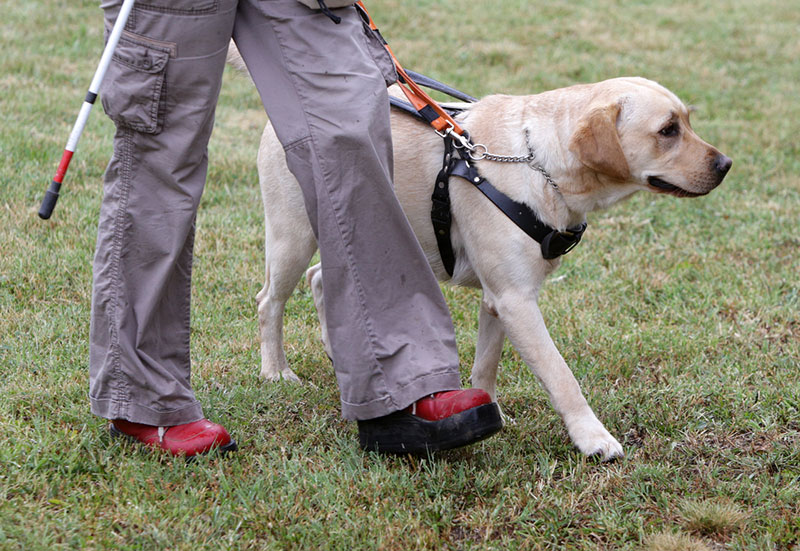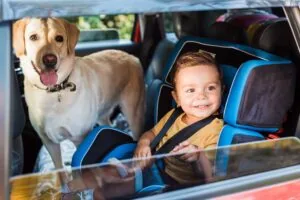About Service Dogs and the Lives They Help

Service/guide dogs have been used dating from early in the 20th century, but they actually have a history which stretches much further back to ancient times when they were used as trackers and patrols in times of war. The earliest documented use of a dog in warfare happened in around 600 BC, but the Greeks and Romans were big advocates of our four-legged friends and used them extensively. Dogs do so much more than entertain us with tricks or accompany us on walks. Their abilities as service dogs are astounding. Gaining in popularity, dogs that assist people who have seizures play an important role in the lives of their owners.
Seizure Assistance Dogs
People with controlled seizures live a relatively unencumbered life where medication keeps their seizure episodes in check, but some people are not so fortunate. Despite medications, they still have seizures, often at unpredictable times. They are limited in their daily activities, staying close to home due to fear of having a seizure at a time and place that would put them at risk of injury. Can you imagine having a seizure at the grocery store or mall? Seizure assistance dogs give their owners freedom to enjoy life without a cloud hanging over their heads. These amazing dogs provide safety, security, and companionship.
What types of seizure assistance dogs are there?
There are two types of seizure assistance dogs. The first is the seizure alert/response dog, trained to help the owner during and after a seizure. These dogs bark to alert family members or nearby people at the first sign of a seizure. Some dogs are trained to trigger a pedal-activated alarm if the incident occurs at home. As the seizure ensues, the dog stays by his owner, often lying at his side to prevent injury or break a fall. After the seizure, people are often disoriented, so the dogs prevent injury by blocking access to stairs or intersections and provide a comforting presence as the person re-orients himself to his surroundings. If the person has trouble balancing, the dog helps him to rise and may provide assistance navigating to a pre-determined safe location.
The second type of seizure dog is thought to predict seizures before they occur. The abilities of these dogs are still under scrutiny since most reports about them are anecdotal. Little research has been done to verify this ability, but it is thought that some dogs have an innate sensibility that can be honed with training. In other words, these dogs cannot be trained to predict a seizure, but if this ability is identified in a dog, it can be encouraged and refined. Programs that place seizure alert/response dogs with people find that many of the dogs begin to identify repetitive cues and alert their owners to an oncoming seizure rather than react after it starts. The dog may bark or nip at the owner to get his attention, and when the owner begins to associate the dog’s behavior to his seizure incidence, he can prepare himself for the episode. It is speculated that seizure-predicting dogs perceive minute changes in a person’s demeanor, body language, or fine motor function that precede the seizure. The dogs may also smell biochemical changes in the person’s body odor. People that are alerted before the onset of a seizure can position themselves in a safe place to avoid injury, call for help, or take medication.
The optimum seizure alert/response/prediction dog is one who has a calm disposition, ignores distractions, responds readily to commands, and is alert and sensitive to his handler. These dogs must be well-behaved since they accompany their owners to school, shops, restaurants, and other public places.
Several breeds or mixed breeds have these qualities, including Labrador Retrievers, Golden Retrievers, Border Collies, German Shepherds and many others – an exclusive pedigree is definitely not a requirement. Larger breeds are usually preferred because they have the strength to physically assist their owner during the period of disorientation that follows a seizure.
People with service dogs reap many benefits from their relationship with these amazing animals. As they become more confident and secure, seizure victims feel a sense of well-being that often reduces the number, frequency, duration, and intensity of the seizures. These dog owners are usually happier and have decreased anxiety knowing that their dog is a friend and protector. Those with assistance dogs find that dogs act as a social buffer that improves relationships with people. It is acknowledged that two people are more likely to converse if one of them has a dog that serves as an ice-breaker. Seizure sufferers also develop a feeling of independence that results in better work or school performance. Their increased self-confidence increases their self-esteem so they are happier individuals overall.
Children with seizures reap special benefits of owning a service dog. These young people often feel different and isolated because they have to wear protective helmets or experience side effects of medication that alter their personalities. For these children, the dogs are loyal friends who love them unconditionally and keep them safe. The dogs again serve as a social buffer making it easier for other children to interact with them. Having a dog at school or on the playground can be “cool!” In short, seizure dogs improve the lives of their owners in many ways. Security, safety, independence, and unconditional love are wonderful gifts bestowed by these amazing canines.
Guide Dogs
Dogs, in general, are amazing creatures. But service dogs, like guide dogs, are true standouts. In addition to traditional canine companionship, they play an integral role in the lives of the visually impaired.
How are guide dogs trained?
Some guide dog training facilities breed and raise pups on site. When the pups are weaned from their mothers, they live with foster families who socialize them and provide loving care. At about 16-18 months of age, the dogs return to the facility and begin a 4-6 month period of formal training that marks the beginning of an amazing career. The first 4-5 months is spent with an experienced, sighted trainer for in-depth training. Under the supervision of the instructor, the dog’s last month of training is spent with a blind person who will become his handler and new best friend. Training institutes educate both the dog and the owner. The dog learns to “guide” the person. The person learns to handle, communicate with, and care for the dog. During this process a strong bond develops that enhances the relationship profoundly. The dog learns to navigate various obstacles, but he is never the “leader.” The human part of the dynamic duo is taught how to direct the dog and utilize commands learned in mobility training exercises. In other words, the dog is the driver of the car watching for obstacles and the handler is the navigator determining how to get from Point A to Point B. The human knows where he wants to go and the dog gets him there safely.
Guide dogs are proficient in leading a human safely to a designated location. This entails watching for hazards from above and below. Low hanging tree limbs or power lines, curbs, stairs, and potholes can spell disaster for a blind person.
In addition to heeding commands, guide dogs learn how to reason. If the handler issues a command to cross a street as traffic approaches, the dog learns to disobey. This ability is called intelligent disobedience and is critical to the safety of both human and dog.
Dogs also learn to ignore distractions that interfere with their duties. These remarkable dogs have the willpower not to abandon their owners in pursuit of a stray ball bouncing across their path. Etiquette is another class at service dog school. Good manners are required to visit places where proper behavior is important, such as restaurants or shops.
Guide dogs are truly smart, but there are some things they simply cannot do. They cannot read traffic signals so the handler must determine when to proceed at a crosswalk. Some intersections have auditory signals which help. And even though dogs have good homing instincts, they cannot map out a route to an unfamiliar location. The abilities of the dog and handler work in tandem to successfully navigate the world.
Dog lovers fully realize the benefits of having a canine family member. Medical studies confirm that dogs impact the health of their human companions. Canines have a positive psychological effect making their owners feel more confident and secure. Blind people with guide dogs are better equipped to set out into the world with their trusted friend. A canine companion also relieves depression, stress, and anxiety which improve cardiovascular health. Plus, a blind person with a guide dog is likely to walk more and the additional exercise is a health benefit. People on the street are more apt to communicate with a person walking a dog, so the visually impaired owner enjoys the resulting social interaction.
Search and Rescue Dogs
Dogs play many roles in our lives. Some dogs are playmates. Some are guardians. Some are service dogs. And some dogs are best described as heroes. The canines involved in search and rescue missions are heroic dogs that optimize their natural abilities to help distressed people.
Search and rescue (SAR) dogs spring into action assisting humans during difficult times. They track people lost in the wilderness or those lost after a natural disaster. SAR dogs find Alzheimer’s patients who have wandered away from a care facility. They locate people trapped in debris after an earthquake or buried under an avalanche of snow. SAR dogs adapt to a variety of circumstances and work well under pressure. Dogs are specially equipped to be rescuers and can hone in on a lost person with their amazing sense of smell. With noses that far surpass ours, dogs have more than 100 million sensory receptor sites in the nasal cavity, as compared to 6 million in people. Moreover, the area of the canine brain devoted to analyzing odors is about 40 times larger than the comparable part of the human brain. In fact, it’s been estimated that dogs can smell anywhere from 1,000 to 10,000 times better than people. Dogs simply have a “nose” for rescue work. Humans may readily smell baking cookies, but dogs can detect a lot more because they have an additional olfactory organ that increases their ability to smell.
What are the types of rescue dogs?
Although all SAR dogs depend on their sense of smell, they are distinguished as either air-scenting or trailing dogs. Air-scenting dogs detect human scent that is airborne and often work off-lead to cover large areas of land. They are usually non-scent-discriminating, meaning that they detect scent from any human as opposed to a specific person.
By comparison, trailing dogs are trackers that can discriminate the scent of a specific person after smelling an article of clothing or object touched by the missing person. These scent-specific dogs track by keeping their noses to the ground, only occasionally raising their heads to detect air-borne particles. Trailing dogs work both on and off-lead and follow the actual path taken by the missing person.
How do air-scenting dogs work?
Air-scenting dogs follow diffused or wind-borne aromas until they find the site where the smells originated. Once they find the source of the odor, these SAR dogs call their handlers by barking. If the handler is far away, the SAR dog may return to the handler and guide him to the scent origin, i.e. the lost person.
Since air-scenting dogs detect air-borne particles, weather conditions affect their job performance. Wind speed, temperature, humidity, and wind direction all impact the dog’s ability to work. Amazingly, despite less than optimal conditions, these talented dogs can cover a search area that may range from a few blocks to 150 acres and can detect a scent source as far as a ¼ mile away. Although an astute sense of smell is a generalized canine trait, some dogs perform better than others. Air-scenting SAR dogs are often herding or sporting breeds, such as Border Collies, German Shepherds, Golden Retrievers, Springer Spaniels, or Labrador Retrievers.
How do trailing dogs work?
Trailing dogs follow a specific scent left behind by a missing person on earth and vegetation. They are so focused in on the scent that they can accurately map turns or even “double backs” taken by the lost person. The discerning noses of tracking dogs can rule out other human scents and focus on the “smell of the day”, an important aspect of successful rescue missions. Since these dogs often work on-lead and move at a slower pace than their air-scenting co-workers, the handlers of tracking dogs are usually close by.
Most people identify Bloodhounds as the premier tracking dog, but other breeds perform well too. Sporting, working, and herding breeds excel at the task. Larger, sturdier breeds can adapt to rough terrains and face grueling conditions. Handlers must also be able to face the physical challenges of search and rescue missions.
In times of disaster, air-scenting and trailing dogs may work together. Air-scenting dogs are released in high-probability areas or places where the lost person is likely to be and scan broad swaths of terrain. Tracking dogs are deployed from the person’s last known point (LKP) or the site of a discovered piece of evidence and maneuver outwards from there. Both types of SAR dogs must be able to work 4-8 hours straight and not be distracted by human rescue workers or wildlife. As crucial team members, handlers must be proficient in wilderness survival techniques when working in rough terrain.
Both air-scenting and tracking dogs can be cross-trained as cadaver dogs that are used to locate the remains of deceased victims. These dogs work over large areas in the event of natural disasters (hurricanes, floods, tornadoes) or small areas (specific crime scenes).
What training is required to become a SAR dog?
A good nose is not enough. A proficient SAR dog needs lots of training, starting with basic obedience skills. Then SAR dogs learn how to track, signal their handlers, and behave appropriately in stressful situations. Their handlers need training, too. Handlers are often trained as law enforcement, fire service, and emergency response professionals.
Young pups begin training as early as 8-10 weeks old and go on the job by 1 or 1 1/2 years of age. Since the job is physically demanding, SAR dogs often retire when they are 5-10 years old. These hard-working canines then enjoy a much-deserved retirement, often alongside their handlers where they are part of the family.
Given the right training and proper temperament, a dog can become a service dog to help those with disabilities because there is no set breed for being a service dog. These dogs can make life much easier, and in some cases can even save your life.
Share This Post
Recent Posts
About Shallowford Animal Hospital
Shallowford Animal Hospital and The Pet Spa at Shallowford are dedicated to the exceptional, compassionate care your pet deserves. Pets hold a very special place in our families, and we treat yours like our own.



